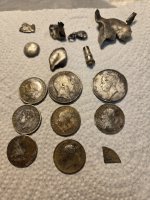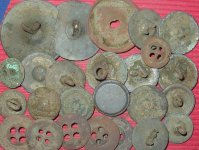Patriot Relics
Silver Member
- Feb 6, 2014
- 3,708
- 5,569
- 🥇 Banner finds
- 5
- Detector(s) used
- CTX-3030, Deus XP II
- Primary Interest:
- Relic Hunting
Hey guys,
Linked up with DownNDirty on a promising site that was once a British camp. The site was originally occupied by colonial militia, but was later vacated after the fall of Charlestown. Given Glenn's (DownNDirty's) recent pewter find we can confirm occupation by the 71st Regiment of Foot among others.
This was no easy dig- the site is incredibly remote and covered in dense overgrowth, but with finds like these we are sure to return. My first target was a small copper thimble...only minutes after turning on the detector. I also managed to snipe a piece of Dirty's buckle pictured in an earlier post (I will be returning it to complete his adjoining pieces) .
.
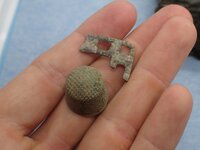
Picking through the iron the next target was a smooth copper disk- probably a KG2 given the sites age.
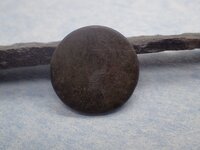
After this this dig, the targets became few and far between. To stay busy I starting digging deep iron hoping for British camp relics. First out was a iron ladle/pot handle fresh out of the electrolysis bath.
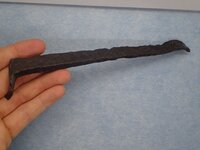
The next target was probably my favorite, partial brown bess barrel. This one looked like a hollow hunk of rust but cleaned up well. Apparent the .69 round ball found a few feet away is still a perfect fit. Can't quite make out the proofing stamp-
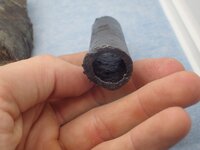
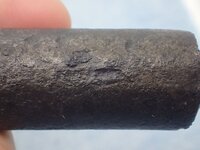
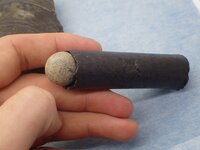
After 8 hours of swinging, I did managed a single white metal flat button with iron loop shank. Given the sites temporary use as a field hospital and the British manufacture, its certainly possible it belonged to a soldier, however impossible to be certain.
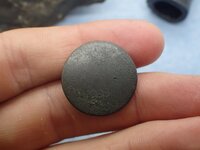
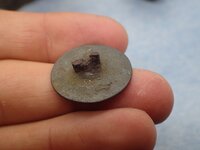
Hessian soldiers in particular were known to wear unmarked white metal buttons of this variety and a few are depicted in Troiani's book.
According to one official report, the British army remained “reasonably” healthy in mid-July 1780. But if so, their health quickly deteriorated after that time and they remained sickly throughout the fall. The spread of diseases was facilitated by the constant movement of British soldiers and camp followers to and from the lowcountry...for all their blundering, the British might well have succeeded in their southern strategy had it not been for the diseases that weakened their army. The garrison at Charleston became increasingly sickly throughout the fall, with the Hessians suffering especially heavily.
The last target really tells a story of what became of the site. Initially I though it was a melted bell however a bit of research revealed that it is a early 18th century bell metal mortar and pestle. Crazy to think of the heat required to melt such a heavy piece of brass.
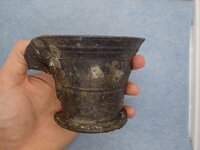
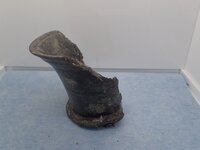
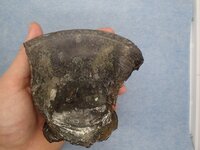
Here's what it may have looked like during the occupation
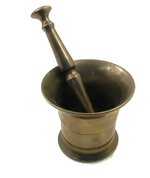
All in all a fantastic hunt with some killer 18th century finds. Can't wait to get back and dig a regimental of my own. Thanks for looking!
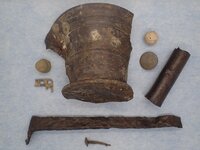
Linked up with DownNDirty on a promising site that was once a British camp. The site was originally occupied by colonial militia, but was later vacated after the fall of Charlestown. Given Glenn's (DownNDirty's) recent pewter find we can confirm occupation by the 71st Regiment of Foot among others.
This was no easy dig- the site is incredibly remote and covered in dense overgrowth, but with finds like these we are sure to return. My first target was a small copper thimble...only minutes after turning on the detector. I also managed to snipe a piece of Dirty's buckle pictured in an earlier post (I will be returning it to complete his adjoining pieces)
 .
. 
Picking through the iron the next target was a smooth copper disk- probably a KG2 given the sites age.

After this this dig, the targets became few and far between. To stay busy I starting digging deep iron hoping for British camp relics. First out was a iron ladle/pot handle fresh out of the electrolysis bath.

The next target was probably my favorite, partial brown bess barrel. This one looked like a hollow hunk of rust but cleaned up well. Apparent the .69 round ball found a few feet away is still a perfect fit. Can't quite make out the proofing stamp-



After 8 hours of swinging, I did managed a single white metal flat button with iron loop shank. Given the sites temporary use as a field hospital and the British manufacture, its certainly possible it belonged to a soldier, however impossible to be certain.


Hessian soldiers in particular were known to wear unmarked white metal buttons of this variety and a few are depicted in Troiani's book.
According to one official report, the British army remained “reasonably” healthy in mid-July 1780. But if so, their health quickly deteriorated after that time and they remained sickly throughout the fall. The spread of diseases was facilitated by the constant movement of British soldiers and camp followers to and from the lowcountry...for all their blundering, the British might well have succeeded in their southern strategy had it not been for the diseases that weakened their army. The garrison at Charleston became increasingly sickly throughout the fall, with the Hessians suffering especially heavily.
The last target really tells a story of what became of the site. Initially I though it was a melted bell however a bit of research revealed that it is a early 18th century bell metal mortar and pestle. Crazy to think of the heat required to melt such a heavy piece of brass.



Here's what it may have looked like during the occupation

All in all a fantastic hunt with some killer 18th century finds. Can't wait to get back and dig a regimental of my own. Thanks for looking!

Amazon Forum Fav 👍
Last edited:
Upvote
30





